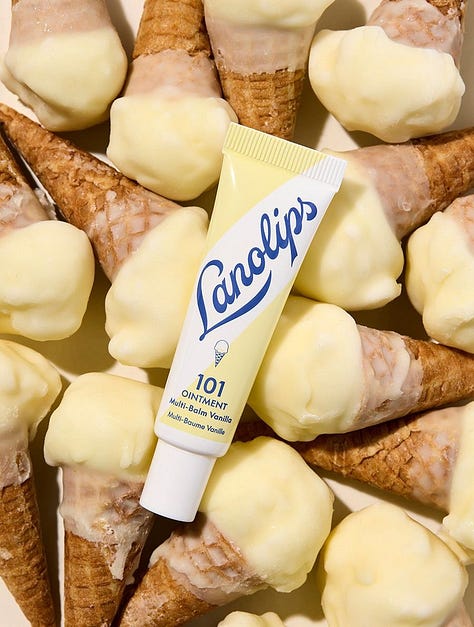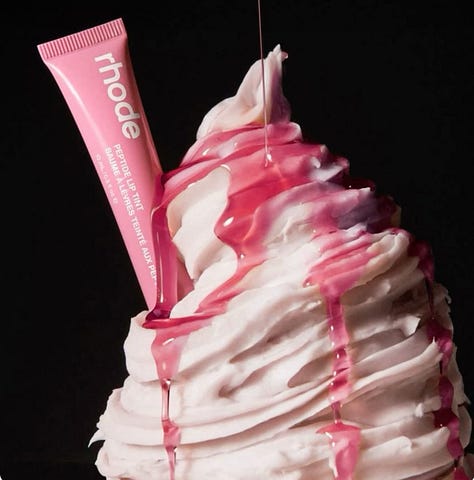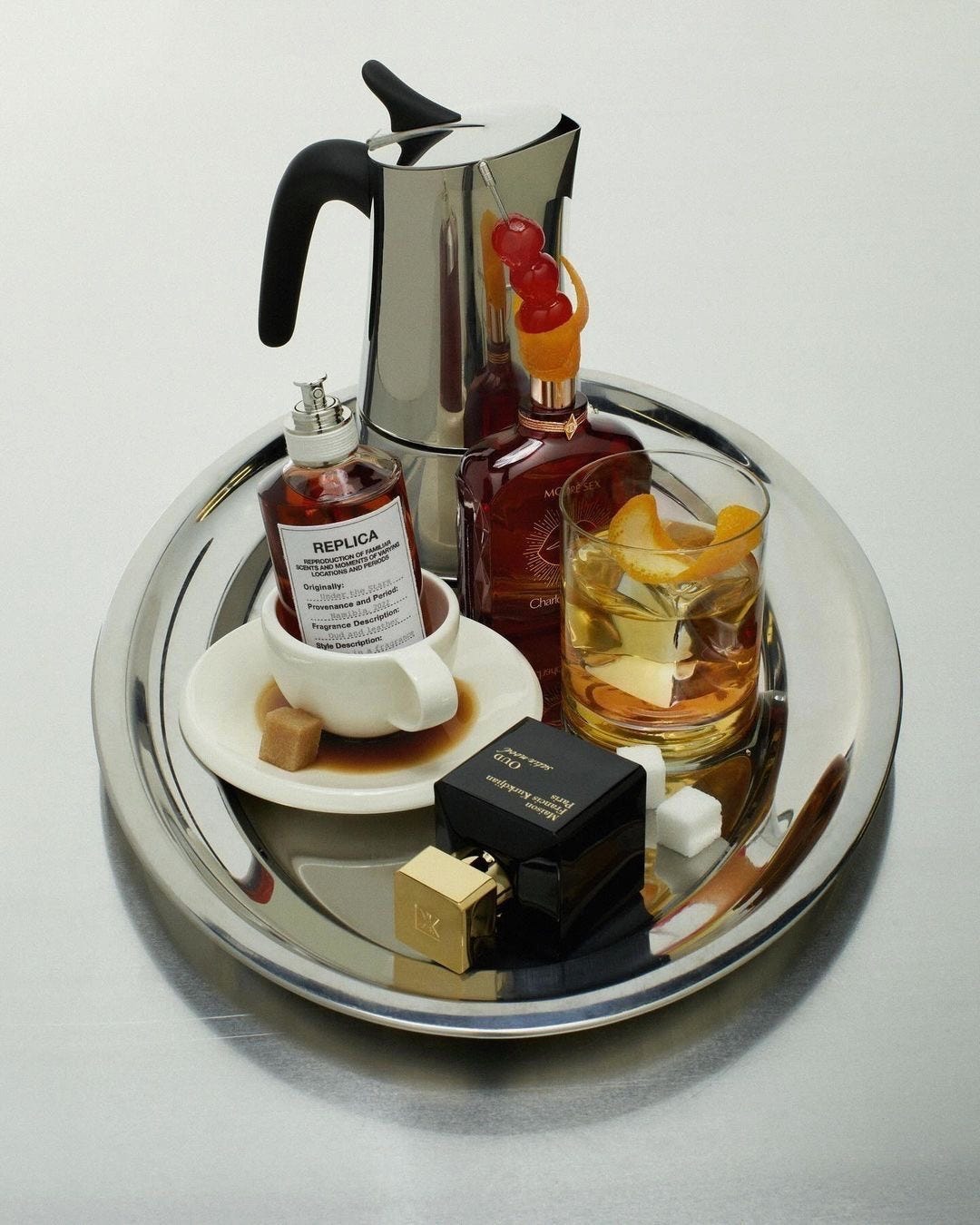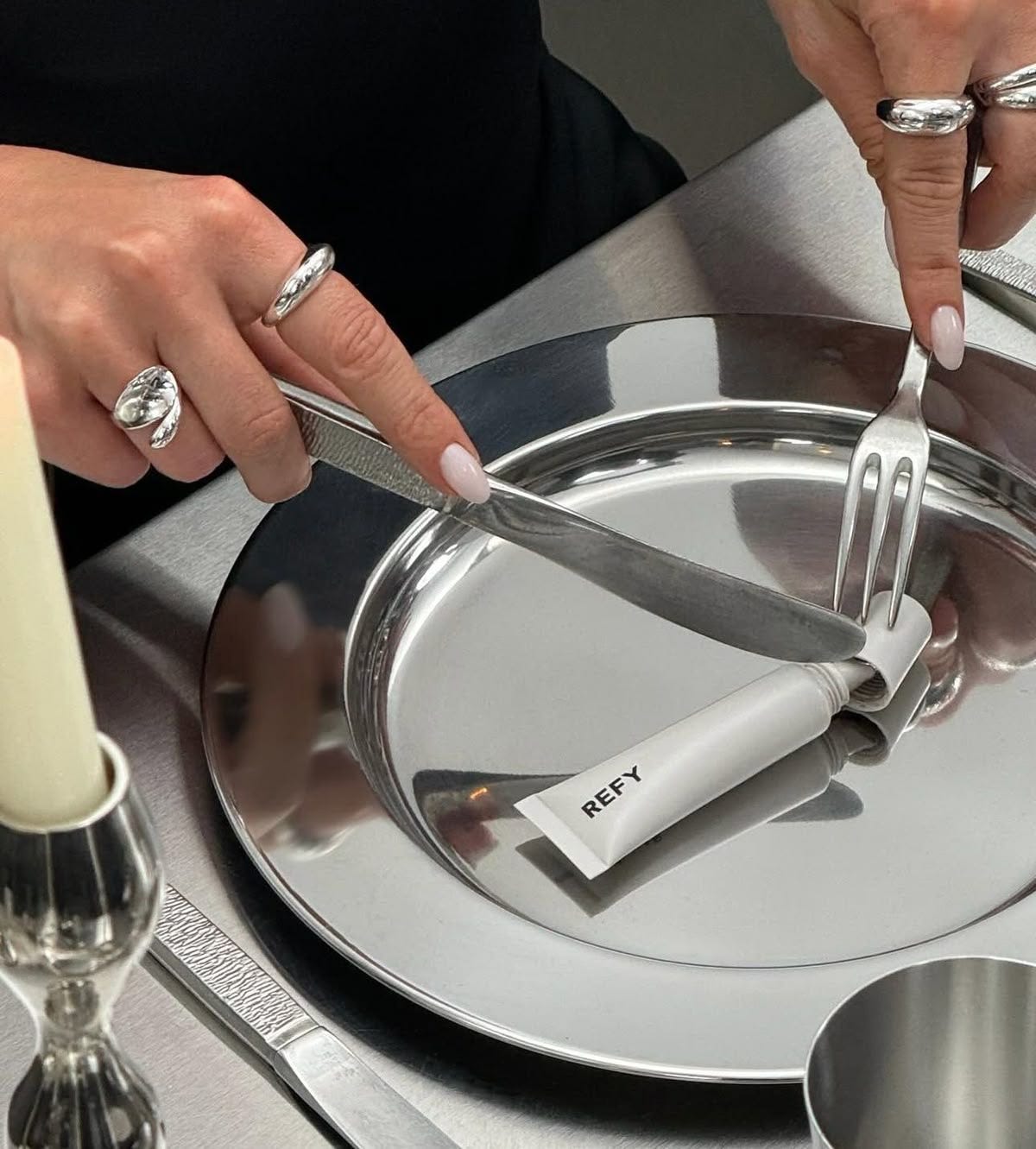Food, Beauty, Status: The Sweet Treat Economy
On The "Foodification of Beauty" and the economics of consumption.
Milky toners, glazed donut skin, barrier butters and gourmand perfumes - it seems almost every recent launch is connected to food. Influencers swatching lip glosses like they’re frosting. Describing textures like mousse, jelly, or whipped cream. Comparing foundation shades to coffee tones. Some of us even store our beauty products in the fridge, further blurring the line between skincare and something edible.
Our senses begin to merge—taste, once reserved for food, seeps into beauty, and the language evolves with it. Lip balms aren’t just scented; they’re flavored. Products aren’t just hydrating; they’re infused with honey or coconut milk.
This Foodification of Beauty creates a cross-over between beauty and food making beauty products feel just as consumable and satisfying as food.
What’s on the menu?
How food has transcended beyond nourishment and become part of creative direction and marketing - merging with fashion, beauty and consumerism.
How Consumer Goods act as a vessel for affordable luxuries to exist.
People view health as wealth.Food and luxury food have become a status symbol. We’re not just talking about Michelin star dining – think Erewhon smoothies, Oishii Strawberries and David’s Protein Bars.
Let’s Digest!
Your Starter
During times of economic uncertainty, people naturally shift their consumption habits as this happens the concept of inelastic goods becomes important.
Econ 101: Elastic vs. Inelastic Goods
Food is one of the few necessities we consume on a daily basis. For most, spending money on food is their main daily expense. Everyday that you wake up is a day you eat. Regardless of the price of food, people will still buy it. For example if the market price of a food staple like bread jumps to $100, it will still be bought by everyone who has $100. The demand for food is not impacted by an increase in price - making it an inelastic good.
Let’s put this in the context of makeup, a consumer category that is almost always considered a luxury. A blush is typically around $12, now let’s say economic shifts cause this blush to now be $100, the blush will gather dust on the shelves - it’s not a necessity, so price and demand have a negative relationship. As the price increases, demand decreases. Thus blush is an Elastic Good, where demand is sensitive to changes in price.
Think of elasticity like a rubber band. A highly elastic rubber band stretches and contracts easily—just as demand for an elastic good expands when prices drop and shrinks when prices rise. But an inelastic good is like a stiff band that barely moves regardless of how much force (or in this case, price changes) is applied. Typically, when prices go down, demand increases, and when prices go up, demand decreases. But for inelastic goods, price changes have little effect on demand—because these are things people can’t easily live without.
Let’s try the Sides before jumping to the Main Course
Consumer goods often act as a gateway to affordable luxury. While not everyone can justify splurging on a $2,000 Gucci handbag, a $40 bronzer or $100 perfume is more within reach. These purchases fall under the category of “inelastic goods”—items that people still buy, even during economic downturns, if their budgets allow.
This phenomenon is encapsulated by the concept of The Lipstick Index, which suggests that when the economy faces uncertainty, sales of inexpensive luxuries like lipstick tend to rise. On the surface, an uptick in lipstick sales might seem like a sign of prosperity and increased disposable income. However, it's often a marker that consumers are trading down from high-ticket luxury items to more accessible indulgences. Instead of an $800 leather handbag or a $400 pair of designer shoes, the “treat” becomes a $20 lipstick or a $100 fragrance.
Luxury brands have taken note, which is why fashion houses like Louis Vuitton are expanding into beauty. This strategic move ensures they remain relevant across economic cycles—whether consumers are indulging in iconic Speedy bags during times of prosperity or opting for a more affordable branded setting powder when budgets tighten. By diversifying their offerings, these brands future-proof themselves, maintaining customer loyalty and capturing a broader share of the luxury market, no matter the financial climate.
Interestingly, this strategy mirrors the evolving relationship between food, wellness, and luxury. Like beauty products, food is a consumable with a finite lifespan—once you finish that Erewhon smoothie or hit pan on a high-end bronzer, it’s gone. Unlike a handbag that can be used indefinitely, these purchases demand consistent replenishment, making them a steady source of revenue for brands.
This phenomenon explains two key trends:
Why Luxury Brands Are Expanding into Beauty and Food: By selling consumables, they secure repeat purchases while maintaining an air of exclusivity.
Why Beauty Brands Are Using Food-Inspired Marketing: Products described as “milkshake lip glosses” or “glazed donut serums” create an approachable, playful luxury that feels both attainable and indulgent.
Now We’re Ready for The Main Course
If your FYP looks anything like mine, it’s overflowing with beauty products named after butters, fruits, sauces, and sweets. Candy-scented lip balms are no longer just a nostalgic relic of the Lip Smackers era—they’ve become the blueprint for modern beauty branding.
Why Does Beauty Keep Leaning into Food?
The Sweet Treat Economy
We all are familiar with the joy a little treat can give you, que the “ it’s like a reward” Tiktok audio. A coffee from your favorite shop, a donut at the end of a long week, a round of drinks at the bar—these moments of indulgence feel small, yet deeply satisfying. But these aren't just personal rituals; they’re part of a larger consumer behavior pattern. What I call - The “Small Treat Economy” , which thrives in precarious financial times.



When money is tight, people still seek indulgence, but they adjust their spending. Full-course dinners and lavish shopping sprees get swapped for small luxuries—affordable pleasures that offer just enough to satisfy. Instead of using Resy for reservations, consumers turn to Instacart for home-cooked meals. The $60 brunch might be out of budget, but a $6 latte or a $10 cocktail still provides that dopamine hit. This shift in consumer behavior explains why beauty brands strategically align their products with food—particularly treats. I think this alignment is created two ways:
It acknowledges beauty as non-essential, while simultaneously tying it to necessity.
Beauty products are, at their core, luxury items. But by mirroring food—specifically, baked goods, confections, and sweet indulgences —they borrow the comforting, nostalgic, and essential nature of food.This is nothing new. Think of Marie Antoinette’s infamous, though likely apocryphal, quote:“Let them eat cake.” Cake is food, yes, but it’s not survival food. It represents decadence, indulgence, and excess. This is why beauty products rarely align with staples like bread or rice—they instead borrow the imagery of desserts (cupcakes, macarons, chocolate soufflé) to reinforce their status as a luxury while remaining accessible.
2. It taps into the desire for finite indulgence.
A treat is temporary—your hot chocolate eventually runs out, just as your hot chocolate-flavored lip balm will. This reinforces the consumption cycle. Unlike a designer handbag (a one-time investment), a beauty product, like a treat, is something you’ll continuously repurchase. By tying beauty to the psychological rhythm of small, recurring indulgences, brands make their products feel as natural as grabbing a coffee on your way to work.The pairing of these two items identifies the consistent consumption cycle of “The Little Treat Economy”.
Necessity Pairing
This is what I’d like to call necessity pairing, a strategy where brands deliberately link their products to everyday essentials, positioning them as something consumers can’t live without. It mirrors a symbiotic relationship, where the product thrives by attaching itself to genuine needs, blurring the line between want and necessity.It functions like a symbiotic relationship, where the product thrives by attaching itself to a fundamental human need. Since food is an inelastic good (people will always buy it regardless of price), while beauty products are elastic goods (people cut back on them in tough times), pairing the two psychologically anchors beauty products closer to necessity.Consumers who might resist spending $50 on a face cream may have no problem picking up a Sugar Cookie lip balm, because the branding frames it as an affordable, justifiable treat—something small, fleeting, and ultimately deserved.
Since food is one of the most fundamental human necessities and an inelastic good, pairing elastic goods like beauty products with food names and scents tricks consumers into subconsciously categorizing these products as essential, rather than indulgent.Consumers may resist splurging on high-end beauty, but framing it like an essential "treat" (think "chocolate soufflé body butter" or "berry smoothie lip balm") makes it feel like a small, justifiable pleasure—like grabbing a coffee or dessert. And let’s be honest we all know the lore of a small treat.
And Lastly, For Dessert
The Final Bite: Why This Strategy Works
Luxury brands are paying attention. We see high-end fashion houses like Louis Vuitton launching beauty lines, ensuring they capture consumer spending whether people are splurging on Speedy bags or justifying a $60 foundation.
At the same time, food and wellness have become the new markers of status. It’s not just about fine dining anymore—grocery shopping has turned into a flex. Think Erewhon smoothies, Oishii strawberries, and hand-harvested sea salt. Just like a luxury lipstick is more accessible than a designer bag, an $18 smoothie is an easier buy than a Michelin-star meal.
Beauty brands have smartly positioned themselves within this economy, making sure their products feel just as satisfying—and essential—as a daily treat.
So next time you pick up a vanilla-scented body oil or a coffee-colored bronzer, ask yourself: Am I buying this because I need it? Or because it feels like a “small treat”?
Either way, the industry has already won. And honestly? I’m consuming.
Thanks For Consuming!
Phia
p.s - Rhode is notably THE brand cashing in on this, I could go on and on but I’ll save a “case study” for a part two!!
“Each Day Gets Better”








